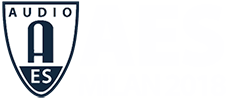AES Milan 2018
Paper Session P04
P04 - Loudspeakers-Part 2
Wednesday, May 23, 14:00 — 16:30 (Scala 4)
Chair:
Jamie Angus, University of Salford - Salford, Greater Manchester, UK; JASA Consultancy - York, UK
P04-1 Live Sound Subwoofer System Performance Quantification—Adam J. Hill, University of Derby - Derby, Derbyshire, UK
The general aim of live sound reinforcement is to deliver an appropriate and consistent listening experience across an audience. Achieving this in the subwoofer range (typically between 20-100 Hz) has been the focus of previous work, where techniques have been developed to allow for consistent sound energy distribution over a wide area. While this provides system designers with a powerful set of tools, it brings with it many potential metrics to quantify performance. This research identifies key indicators of subwoofer system performance and proposes a single weighted metric to quantify overall performance. Both centrally-distributed and left/right configurations are analyzed using the new metric to highlight functionality.
Convention Paper 9925 (Purchase now)
P04-2 Don't Throw the Loudspeaker Out with the Bathwater! Two Case Studies Regarding End-of-Line Tests in the Automotive Loudspeaker Industry—Enrico Esposito, Ask Industries S.p.A. - Monte San Vito, Italy; Angelo Farina, Università di Parma - Parma, Italy; Pietro Massini, Ask Industries S.p.A. - Monte San Vito (AN), Italy
Mass production of loudspeakers drivers for the automotive market is subjected to the strong requirements dictated by the implementation of the sector Quality System and is heavily conditioned by the low profit margin of what is seen (and actually is) a commodity as many other components of a vehicle; but, differently from other components, a loudspeaker is a complex system made of parts whose performance depends on many factors, including ambient conditions. For these reasons it is quite difficult to impose tight tolerances on loudspeakers and a fair agreement must be found between suppliers and customers to avoid scraping samples that are fine under any aspect, especially considering that the final judgment mainly stays, although not exclusively, in the ears of the end user. In this work two case studies are presented to show how tolerances could be fixed reasonably.
Convention Paper 9926 (Purchase now)
P04-3 Fast and Sensitive End-of-Line Testing—Stefan Irrgang, Klippel GmbH - Dresden, Germany; Wolfgang Klippel, Klippel GmbH - Dresden, Germany
Measurement time is a crucial factor for the total cost and feasibility of end-of-line quality control. This paper discusses new strategies minimizing the test time for transducers and audio systems while ensuring high sensitivity of defect detection, extracting comprehensive diagnostics information and using available resources in the best possible way. Modern production lines are fully automated and benefit highly from high speed testing. Optimal test stimuli and sophisticated processing in combination with multichannel test design are the key factors for smart testing. Appropriate acoustical, mechanical, and electrical sensors are discussed and suggested. Furthermore, parallel or alternating test schemes reduce the overall test time. Finally, typical concerns and pitfalls when testing at high speed are addressed and illustrated by measurement results.
Convention Paper 9927 (Purchase now)
P04-4 Optimal Material Parameter Estimation by Fitting Finite Element Simulations to Loudspeaker Measurements—William Cardenas, Klippel GmbH - Dresden, Germany; Wolfgang Klippel, Klippel GmbH - Dresden, Germany
Important characteristics for the sound quality of loudspeakers like frequency response and directivity are determined by the size, geometry, and material parameters of the components interfacing the acoustic field. The higher-order modes after cone break-up play an important role in wideband transducers and require a careful design of the cone, surround, and other soft parts to achieve the desired performance. Finite Element Analysis is a powerful simulation tool but requires accurate material parameters (complex Young's modulus as a function of frequency) to provide meaningful results. This paper addresses this problem and provides optimal material parameters by fitting the FEA model to an existing loudspeaker prototype measured by Laser vibrometry. This method validates the accuracy of the FEA simulation and gives further information to improve the modeling.
Convention Paper 9928 (Purchase now)
P04-5 Vision Methods Applied to Measure the Displacement of Loudspeaker Membranes—Thomas Durand-Texte, Le Mans Université - Le Mans, France; Manuel Melon, Le Mans Université - Le Mans cedex 9, France; Elisabeth Simonetto, Laboratoire Géomatique et Foncier - Le Mans, France; Stéphane Durand, Laboratoire Géomatique et Foncier - Le Mans, France; Marie-Hélène Moulet, Centre de Transfert de Technologie du Mans - Le Mans, France
Increased interest has been witnessed over the past decades for techniques measuring the vibration of a loudspeaker membrane. In this proceeding, vision methods have been adapted to measure the displacement of the cones of low-frequency drivers. The movement of the membrane is recorded with industrial or consumer market high-speed cameras with frame rates greater than or equal to 240 fps. The measured displacement shows acceptable to very good agreement with the one measured by a laser vibrometer, depending on the camera model. The displacement of the membrane, coupled to the measured electrical impedance, can be used to retrieve the small signal parameters or some non-linear parameters of the speaker. Finally, the vision methods are used to retrieve the vibration patterns of the membrane.
Convention Paper 9929 (Purchase now)
